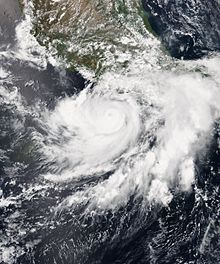 Carlos near its initial peak intensity on June 13 | |
| Meteorological history | |
|---|---|
| Formed | June 10, 2015 |
| Remnant low | June 17, 2015 |
| Dissipated | June 18, 2015 |
| Category 1 hurricane | |
| 1-minute sustained (SSHWS/NWS) | |
| Highest winds | 90 mph (150 km/h) |
| Lowest pressure | 978 mbar (hPa); 28.88 inHg |
| Overall effects | |
| Fatalities | None |
| Damage | $1.4 million (2015 USD) |
| Areas affected | Southwestern and Western Mexico |
| IBTrACS / [1] | |
Part of the 2015 Pacific hurricane season | |
Hurricane Carlos was an unusually small tropical cyclone which affected the western coast of Mexico in June 2015. Forming as the third named storm and hurricane of the annual hurricane season, Carlos developed from a trough first noted by the National Hurricane Center on June 7. The disturbance gradually organized and was designated as a tropical depression three days later while south of the Mexican Pacific coast. Drifting slowly northwestward, the depression was upgraded further to a tropical storm. Although persistent wind shear and dry air hampered intensification early on, Carlos strengthened into a hurricane on June 13 after moving into a more favorable environment. However, the return of dry air and upwelling of cooler waters caused the system to deteriorate into a tropical storm. Paralleling the Mexican coast, Carlos later regained hurricane intensity on June 15 and attained peak winds of 90 mph (140 km/h) a day later. The reprieve was brief, however, as the onset of wind shear, land interaction, and dry air afterward led to rapid weakening. On June 17, Carlos degenerated into a remnant area of low pressure, having made landfall in Jalisco earlier that day. By the morning of June 18, Carlos was declared to have completely dissipated.
Carlos's close track to Mexico prompted coastal authorities to enact precautionary measures along states deemed at risk, including the issuance of tropical cyclone warnings and watches over a large swath of the coast, extending from Acapulco to Cabo Corrientes. In Guerrero, more than 500 shelters were opened, and schools in most of the state were closed. Rough seas along the shore generated by the hurricane caused widespread damage, which included the sinking of 12 ships in Playa Manzanillo harbor. The waves combined with heavy rain to inflict at least MXN$5 million (US$326,000) of damage on Michoacán's coastal installations. Strong winds produced by the passing storm also downed trees, power poles, and billboards along much of the western Mexican coast. In Jalisco, classes were also suspended in anticipation of heavy rains, however, damage in the state was relatively minor. Overall, Carlos caused roughly MXN$16 million (US$1.04 million) worth of damage across Mexico.
